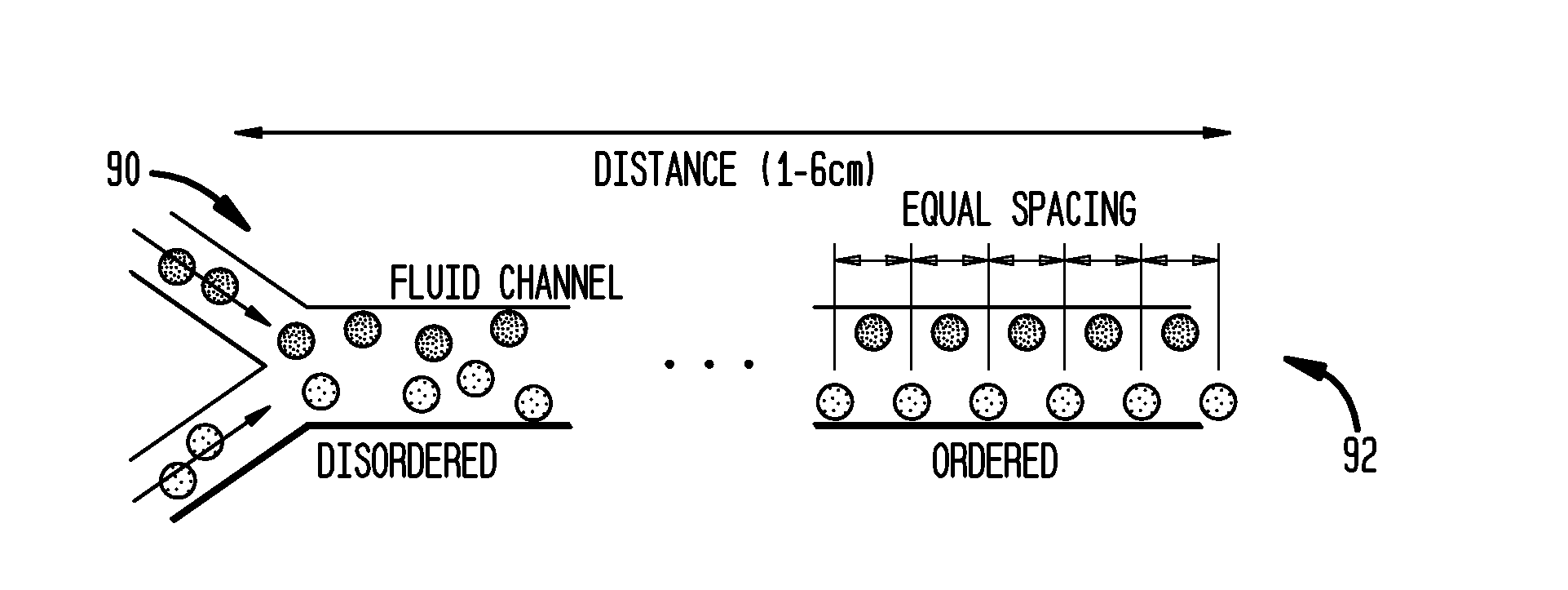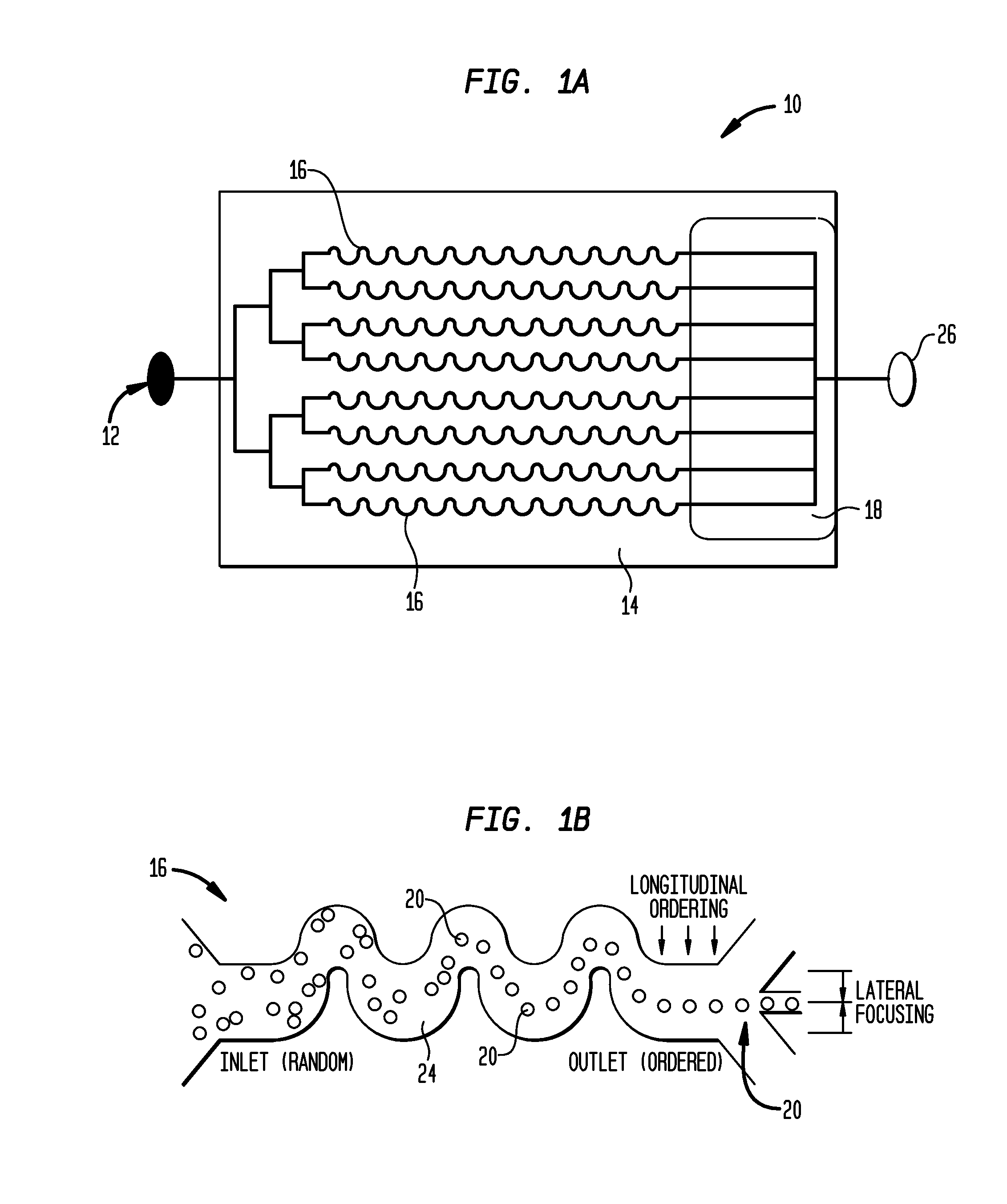Systems and methods for particle focusing in microchannels
- Summary
- Abstract
- Description
- Claims
- Application Information
AI Technical Summary
Benefits of technology
Problems solved by technology
Method used
Image
Examples
example 1
[0211]Ordering and focusing of particles in the various channel geometries described herein is unaffected by relative particle density, as will be discussed in reference to FIGS. 16A-16C. When the density of the suspending solution is changed so that the suspended particles are either more or less dense than the solution (i.e., positive or negative buoyancy) focusing can be unperturbed and can remain at a consistent location, as illustrated in FIGS. 16A and 16B. For example, when particles both less dense (silicone oil, ρ=0.95 g / ml) and more dense (polystyrene, ρ=1.05 g / ml) than the suspending fluid (ρ=1.00 g / ml), are loaded simultaneously, both will focus to the same position, as shown in FIG. 16C. The independence of particle density for particle focusing is not consistent with a dominant centrifugal force acting directly on particles and suggests that Dean drag FD is the dominant effect leading to symmetry reduction.
[0212]In particular, as noted in detail above, effects present i...
example 2
[0214]Particles within the exemplary channel geometries described herein can be ordered and focused with extreme precision and with stability, as shown in FIGS. 17A and 17B. In particular, the stability of the focused streams of particles over time is assayed to demonstrate the utility of the phenomenon for focusing in flow cytometer and coulter counter systems. The stability and precision of inertially focused streams can be characterized by imaging a solution of 10-μm polystyrene particles over 10 minutes of continuous flow at Rp=0.24. In the example shown in FIGS. 17A and 17B, each image had an exposure time of 700 ms, sampling an average of 1,100 passing particles. In FIG. 17A, intensity profiles are obtained from each stream and a Gaussian fit is made to this profile. There are two parameters involved: the center position of the Gaussian fit and the full width at half maximum extracted and plotted for each time point. In FIG. 17B, these two parameters are plotted for each point...
example 3
[0215]FIGS. 18A-18D illustrate that in addition to the focusing of particles across the transverse plane of the channel, self-ordering of particles in the longitudinal direction, along the flow lines can also occur. High-speed imaging (2-μs exposure) can be used to reveal characteristic long trains of particles (10-15 particles) with uniform spacing that alternate between the four stable lateral positions in rectangular channels, as shown in FIGS. 18A and 18B, or are concentrated in a single stream for asymmetric channels, as shown in FIGS. 18C and 18D. In particular, FIGS. 18A and 18C represent 10 μm diameter particles in a flow rate of Rc=120. As shown in FIG. 18A, trains of particles tend to alternate between positions instead of occupying several coincidentally. FIGS. 18B and 18D represent autocorrelation functions (ACF) that confirm particle ordering with an average distance of 36 μm in the straight channel and an average distance of 48 μm in the curved channel.
[0216]As illustr...
PUM
| Property | Measurement | Unit |
|---|---|---|
| Size | aaaaa | aaaaa |
| Size | aaaaa | aaaaa |
| Width | aaaaa | aaaaa |
Abstract
Description
Claims
Application Information
 Login to View More
Login to View More - R&D
- Intellectual Property
- Life Sciences
- Materials
- Tech Scout
- Unparalleled Data Quality
- Higher Quality Content
- 60% Fewer Hallucinations
Browse by: Latest US Patents, China's latest patents, Technical Efficacy Thesaurus, Application Domain, Technology Topic, Popular Technical Reports.
© 2025 PatSnap. All rights reserved.Legal|Privacy policy|Modern Slavery Act Transparency Statement|Sitemap|About US| Contact US: help@patsnap.com



